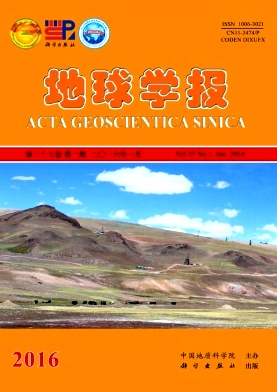QI Bang-shen, HU Dao-gong, YANG Xiao-xiao, ZHANG Yao-ling, TAN Cheng-xuan, ZHANG Peng, FENG Cheng-jun. Apatite Fission Track Study of the Cretaceous-Cenozoic Stepwise Uplift of the Middle Segment of the Qilian Mountain[J]. Acta Geoscientica Sinica, 2016, (1): 46-58. doi: 10.3975/cagsb.2016.01.05
| Citation: |
QI Bang-shen, HU Dao-gong, YANG Xiao-xiao, ZHANG Yao-ling, TAN Cheng-xuan, ZHANG Peng, FENG Cheng-jun. Apatite Fission Track Study of the Cretaceous-Cenozoic Stepwise Uplift of the Middle Segment of the Qilian Mountain[J]. Acta Geoscientica Sinica, 2016, (1): 46-58. doi: 10.3975/cagsb.2016.01.05
|
Apatite Fission Track Study of the Cretaceous-Cenozoic Stepwise Uplift of the Middle Segment of the Qilian Mountain
-
Abstract
The Qilian Mountain constitutes the northeastern margin of the Tibetan Plateau, and hence characteristics of its tectonic activity recorded by apatite fission track (AFT) analysis play an important role in understanding the uplift and growth of the Tibetan Plateau. 22 samples collected for AFT analysis from the Qilian Mountain belt were located along NS-trending transect across southern Qilian fold belt, Shule Nanshan-Laji Shan suture zone, Central Qilian massif and North Qilian suture zone. AFT ages range from (13±2) Ma to (124±11) Ma, and mean track lengths range from (10.3±1.8)μm to (13.6±2.3)μm. Samples from the same tectonic unit have positive correlation between AFT ages and elevations, whereas samples with younger ages ((60±5) Ma to (13±2) Ma) are clustered around North Central Qilian fault. On the basis of the measured apatite fission track age data, the inversion simulation was used to analyze the thermal history of the Qilian Mountain. The best-fit line of the time-temperature modeling results suggest that at least three cooling periods have occurred since early Cretaceous: 1) Rapid cooling in the Qilian Mountain during early Cretaceous (>(129±14) Ma to (115±17) Ma). The cooling rates and exhumation rates of South Qilian fold belt and Shule Nanshan -Laji Shan suture zone were great, suggesting that the Qilian Mountain formed the northeastern margin of the Tibetan Plateau during early Cretaceous; 2) From middle Cretaceous to Miocene ((115±17) Ma to (25±7) Ma), the cooling rates and exhumation rates of South Qilian fold belt and Shule Nanshan-Laji Shan suture zone were quite low, implying that the tectonic activity of the Qilian Mountain was weak during middle Cretaceous to Miocene; 3) Since Miocene time, timing of both thrust activities and regional rapid cooling event shows that the Qilian Mountain experienced north-eastward rise and growth, which is in line with the hypothesis that the Qilian Mountain was formed by thrusting within the Qaidam crust along a large decollement in the lower crust that progressively propagated north-eastward, the Qilian Mountain was uplifted considerably since Miocene, forming basins-mountains tectonic landforms. Early Cretaceous rapid cooling event in the Qilian Mountain probably resulted from the docking of the Lhasa block to the south, and the rapid cooling since Miocene may be the result of the docking of the India-Asia collision, representing the main uplift of the Qilian Mountain.
-

-
-
Access History







 DownLoad:
DownLoad: